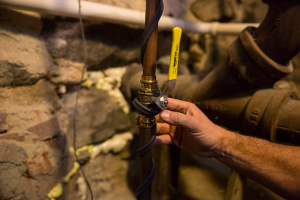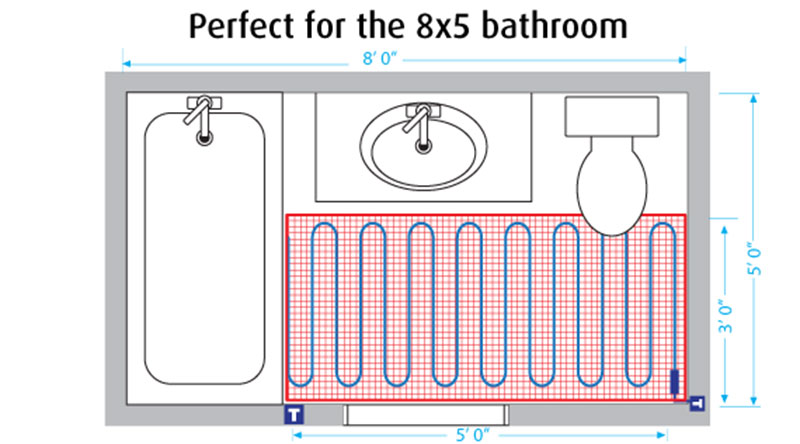Before you decide on a particular radiant floor heating system for your home, an energy audit should be conducted. It’s a great way to pinpoint areas where heat loss is occurring and to get professional recommendations on the most efficient way to correct it.
In order to specify the right system, you will need to know how many BTUs (British Thermal Units) are required to replace the heat that is escaping your home through walls and other surfaces. It is determined by performing a heat load calculation which consists of calculating surface heat loss and heat loss due to air infiltration.
This article will serve as a non-technical guide to what happens during an energy audit and how the calculations are made.
It is recommended that a contractor or systems designer be utilized for the final audit, however, you can prepare for an energy audit by sealing up the obvious leaks around windows and doors and addressing areas where insulation is needed.
6 Steps for Calculating Heat Loss
1. Determine Design Temperature
The first step is to determine the difference between the ideal temperature inside your home and the average temperature that your geographic region never goes below in the winter. The result of this calculation will be called Delta T. If your interior design temperature is around 68 degrees and your average outside winter temperature is 40, then Delta T = 28 degrees which is the difference between the two.
2. Calculate Surface Area
The surface area or wall area of a home will be the total length of the exterior walls x the height of those walls, minus the square footage of the doors and windows in that wall. Heat loss for the doors and windows should be figured separately. If your exterior wall length is 25’ and the wall height is 8’ then the surface area will be 25’ x 8’ = 200 square feet. If the walls contained 36 square feet of windows and doors, the surface area calculation would be 200 – 36 = 164 square feet.
3. Calculate R-Value and U-Value
The R-value of the wall will be based on the insulation in a wall. An uninsulated 2×4 residential wall will have an R value of 4 while the same wall with code approved insulation will have an R value of 14.3. To obtain the U value, divide the R value into 1. The U value in this example would be .07.
4. Calculate Surface Heat Loss
The heat loss in the wall is measured in BTUs and the formula is U value x Wall area x Delta T. In our example, this would be: .07 x 164 x 28 = 321.44 BTUH (British Thermal Units per Hour). This is the amount of heat that is escaping through the exterior walls based on the amount of insulation in them. The other interior surface calculation is for the ceiling. Typical ceiling insulation will be an R-19 which has a U value of .53. This results in a loss of 5,565 BTU per hour.
To calculate the window and door heat loss, you would need to plug their U values into this formula and add it to the total. For instance, a solid wood door with an R value of 4 would have a U value of .25. The formula would look like this: .25 x 21 (3’x7’) x 28 = 147 BTU loss per hour through a single door. A 3’x5’ window with a U value of .65 would lose 273 BTUs per hour.
5. Calculate Air Infiltration Heat Loss
The air infiltration heat loss is uncontrolled heat loss through joints in the construction and cracks around doors and windows. This figure is affected by wind and pressure differentials between the outside and interior of the home which causes air to move inside the home, thereby producing heat loss as that air escapes the room. The formula is: Room volume x Delta T x Air Changes per Hour x .018. In our example, we will assume the room is 25 ’x 15’ x 8’ high. This gives us a room volume of 3,000 cubic feet. Plugging this into the formula we see: 3,000 x 28 x 4 x .018 = 6,048 BTUH.
6. Calculate Total Heat Loss
Total wall heat loss is determined by adding together the loss from the walls, windows, doors and ceiling: (walls) 321.44 + (window) 273 + (door) 147 + (ceiling) 5,565 = (Total Wall Heat Loss) 6,306.44 BTUH.
The total heat loss is arrived at by adding the air infiltration heat loss to this figure:
6,306.44 + 6,048 = 12,354.44 BTU per hour loss that must be supplied from the heating system to maintain an interior temperature of 68 degrees.
Always Work with an Experienced Professional
Companies that specialize in energy modeling or energy audits will have experienced technicians that utilize the latest technology to expose points of heat loss as well as air and moisture infiltration. Identifying these areas is often impossible using a visual inspection as they are hidden beneath flooring, behind walls,and above ceilings. That is why it is highly recommended that you contact a professional company to perform your inspection.
Use Radiant Floor Heating for Efficient Home Heating
Nothing is as comfortable as a warm floor touching cold feet in the winter, and electric radiant floor heating is the ideal system for supplemental heat in a room or for your entire home. Warmup underfloor systems heat up in minutes rather than hours, saving you money and conserving energy. Our systems are UL-approved and provide gentle, even heat to the floor surface to prevent hot and cold spots in a room and leaving the air temperature cooler than other conventional heating methods.
Contact us today for a free quote and let us help you solve your heat loss problems with electric radiant floor heating.



![Which Underfloor Heating Is Best for Me? [Flowchart]](https://www.warmup.ca/wp-content/uploads/underfloor-heating-flow-chart-thumb-300x199-1.jpg)


